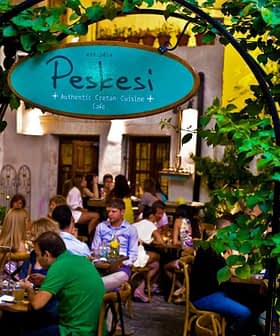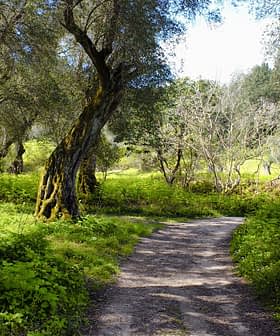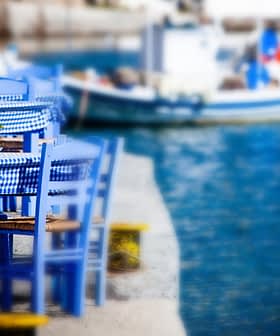Greek olive oil at the Winter Fancy Food Show made in impact this year through a seminar called “The Great Olive Oil Odyssey.” The event was organized by SEVITEL, the Greek association of olive oil processors and related industries.
The seminar was introduced by Aris Kefalogiannis, CEO of the Mediterranean foods company Gaea and Filio Myrtsidou, a marketing consultant.
Myrtsidou is an energetic supporter of Greek olive oil branding who was one of three female participants in the Routes of the Olive Tree in 2008 — a 52-day, 23,000 km motorcycle journey from ancient Messinia in the Peloponnese along the Silk Road to carry a symbolic “flame of peace” and a 4,000 year-old olive wreath to 14 countries, arriving in China for the 2008 Olympics.
The first speaker, Dan Flynn director of the UC Davis Olive Center, made an inspired presentation titled “Beyond Extra Virgin” explaining why not all extra virgins are the same, and why chemical testing alone is not the final measure of EVOO excellence.
UC Davis has been steadily expanding their organoleptic educational and training programs. Flynn explained why some EVOOs can pass chemical analyses “with flying colors” and be judged defective by organoleptic experts.
A defect can occur during at any of the many stages of extra virgin olive oil production and bottling. Flynn said you first need to start with a good olive fruit variety, harvested in a proper manner, at the right time and milled within the same day. Then it msut be stored, bottled, packaged, transported and, finally, delivered to the customer — all under optimum conditions.
The type of mill also plays a role in the quality of the EVOO as does the temperature during the malaxation stage. If water is used in the extraction process it must be less than 27ºC and kept to a minimum in order to maintain the full range of aroma and taste characteristics.
Flynn reminded us the olive is a fruit and EVOO is the juice of the olive. Unlike oils chemically extracted from nuts or seeds, EVOO is extremely sensitive to light, heat and oxygen and can deteriorate very rapidly. A well-trained organoleptic expert can identify defects in any of the stages of production. Some defects cannot be detected by chemical analysis alone. After a thorough chemical analysis, taste is indeed the final arbiter of excellence for EVOO.
Flynn expressed his support for the Nuclear Magnetic Resonance (NMR) method and affirmed a collaboration with American Farm school in Thessaloniki which is modeled after the UC Davis Olive Center in California. An academic multidisciplinary group was created and has the task of connecting with olive industry officials to examine olive tree cultivation and olive oil making processes in Greece.
Many Greek EVOO producers have not understood the importance of submitting their EVOOs to olive oil competitions. Flynn believes they are becoming more important than ever. A thorough chemical analysis coupled with a competition award, or an organoleptic analysis conducted by a well known expert, is an excellent way to gain the customer’s confidence, Flynn explained, and an effective calling card when entering a new territory, especially true for the U.S. market.
Next up was Prokopios Magiatis and Eleni Melliou, the team who invented the NMR method of measuring the individual phenolic compounds in extra virgin olive oil. They continue to discover new testing methods and phenolic compounds in EVOO and they outlined how the emergence of the NMR method has contributed to an expanded awareness of the high quality of Greek olive oil and the best ways to raise the quality even further.
Across Greece small independent growers are achieving commercial success and establishing brands by producing high-phenolic EVOOs combined with excellent organoleptic characteristics.
The team presented their new hand-held colorimetric method of measuring oleocanthal and oleacein in a test tube.
The last lecture was presented by Kostas Peimanidis who is an accreditation systems and PDO certification consultant. He gave a stirring call to action for the Greek olive oil industry by identifying the progress that has been made over the last few years and also the work that still needs to be done.
Today, Greek olive oil imports account for 1.7 percent of the U.S. market, dwarfed by Spanish and Italian olive oils who enjoy a combined 87 percent of market share. Peimanidis mentioned that one out of twenty Greeks have a direct family relation to an olive grove.
Sensory analysis is a must he agreed, and although the PDO seal is a guarantee of authenticity and traceability, taste and smell is what makes the difference. The Technological Educational Institute of Kalamata accredited to ISO 17025 for organoleptic assessment of virgin olive oil is a significant scientific “tool” for selecting the best EVOO, he added.
Peimanidis also drew attention to the official State Seal of California, which contains the image of Athena who according to Greek mythology gifted the olive tree to Athens. It also includes the Greek word Eureka (“I discovered it”). Eureka is the word the ancient scholar Archimedes uttered when he discovered what is known in physics as the Archimedes principle of buoyancy while taking a bath (287 BC– 212 BC).
The “Great Olive Oil Odyssey” was thus redefined by Peimanidis as the “Greek Olive Oil Odyssey.” The Odyssey is a metaphor for the long journey ahead for Greek olive oil to increase its presence in the U.S.
Peimanidis, in his quest to inspire new efforts to market Greek olive oil in the U.S., also proposed that Athens and the California city of Davis could form a sort of brotherhood relationship to highlight their close relationship. Athens representing the mythical origin of the olive tree, and California and UC Davis their never-ending quest for excellence – αἰὲν ἀριστεύειν (ever to excel) derived from the sixth book of Homer’s Iliad and their shared love for excellent EVOO.
I also met with Alkiviadis Kalabokis, managing director of Great Exhibitions company, who organizes educational and promotional events for Greek products. He wanted to convey a more positive perspective on the state of the Greek olive oil industry, and specifically for Crete. “Crete is a leader in branded EVOO exports and has gone from exporting 95 percent of their EVOO in bulk to now exporting less than 70 percent,” he said. “Their efforts are bearing fruit,” he said emphatically.
Indeed in recent articles I have focused more on the problems the Greek olive oil industry needs to focus on and yet I have visited many independent olive growers across Greece and been astounded at their willingness to keep working in the olive groves with very little if any financial return.
Many have lost money now for the second year in a row, either by mismanagement of the fruit fly problem or by the ever-increasing costs of doing business. Not only have they lost profits but they had to sell off assets to pay debts. Some had no choice but to sell high quality EVOO in bulk at rock bottom prices. Their unbending will to continue is a source of great inspiration.
Meanwhile, those who were able to hold on to their EVOO production are being rewarded. Bulk prices for EVOO across Greece are holding steady above €3 per kilo and it is becoming difficult to find anyone willing to sell at these prices.
Prices are expected to rise rapidly from here. Recent high winds, snow and rain across Greece have caused severe losses to the remaining harvest production and the losses are not yet reflected in the latest prices for Greek EVOO in bulk. Truth is, if the farmers had more support from the banks to finance harvesting costs, none of them would have sold at low prices so early to cover their immediate expenses.








